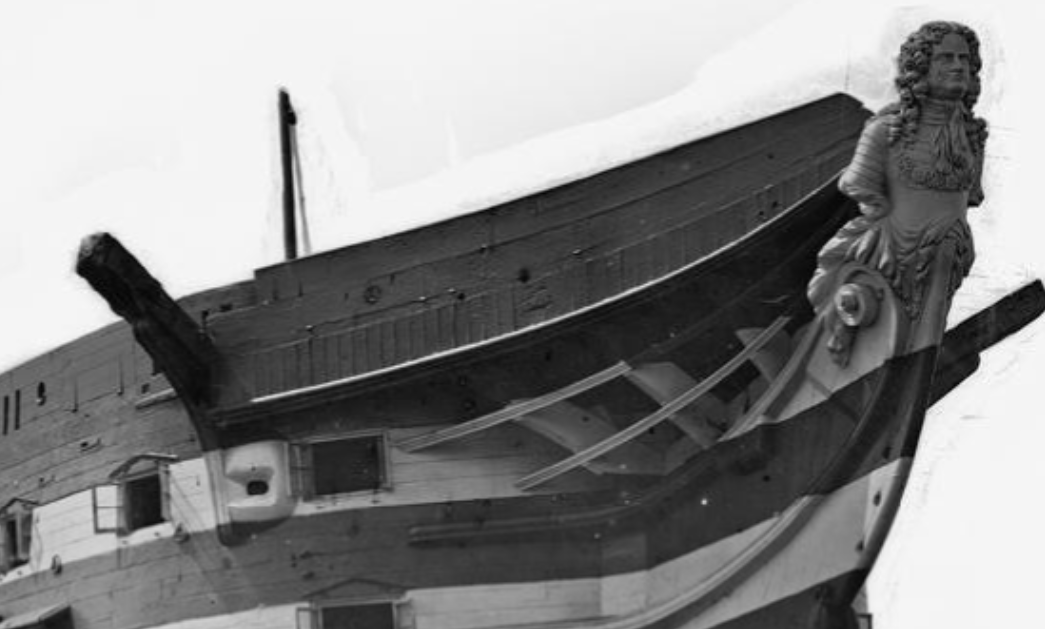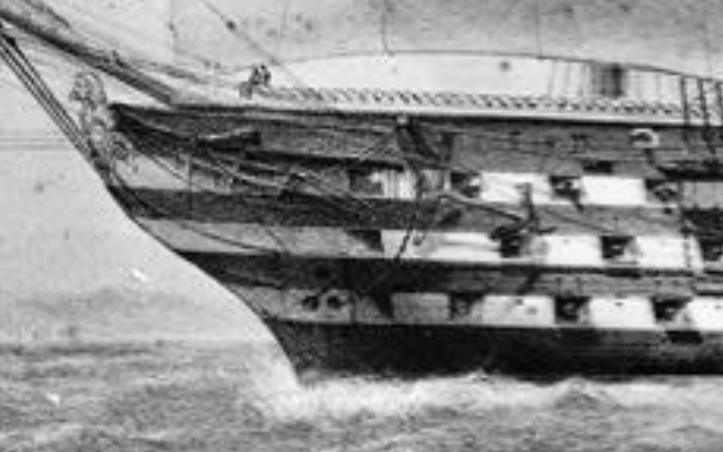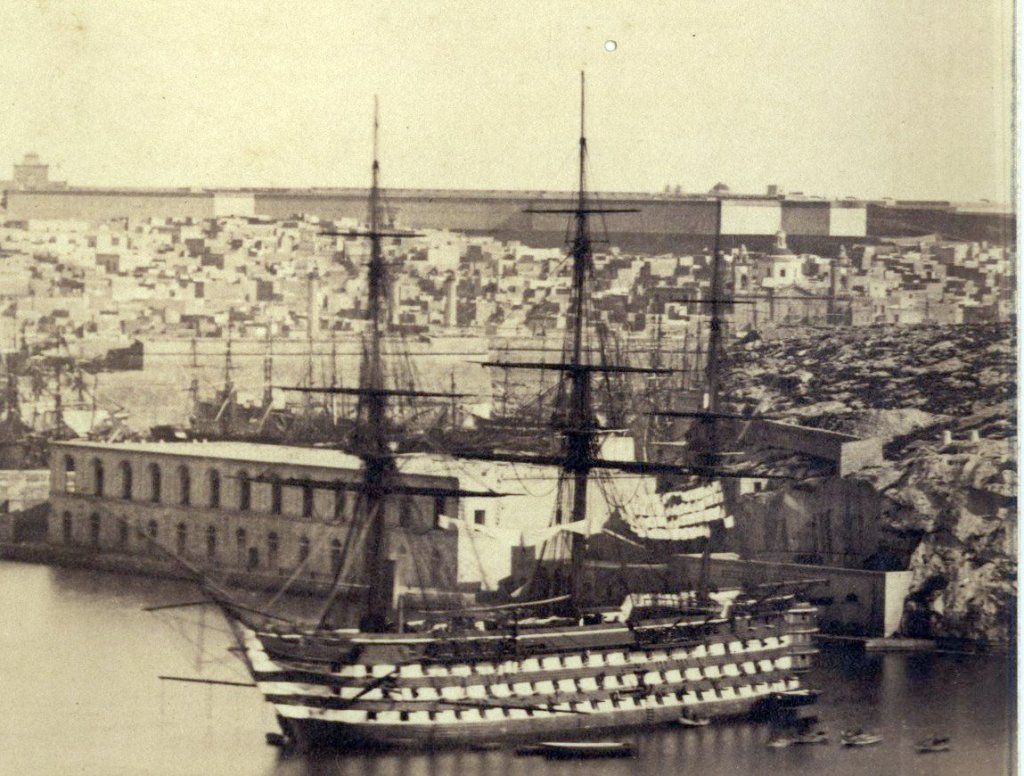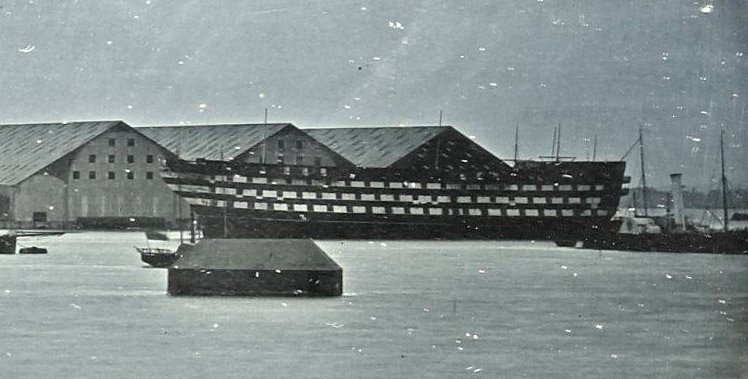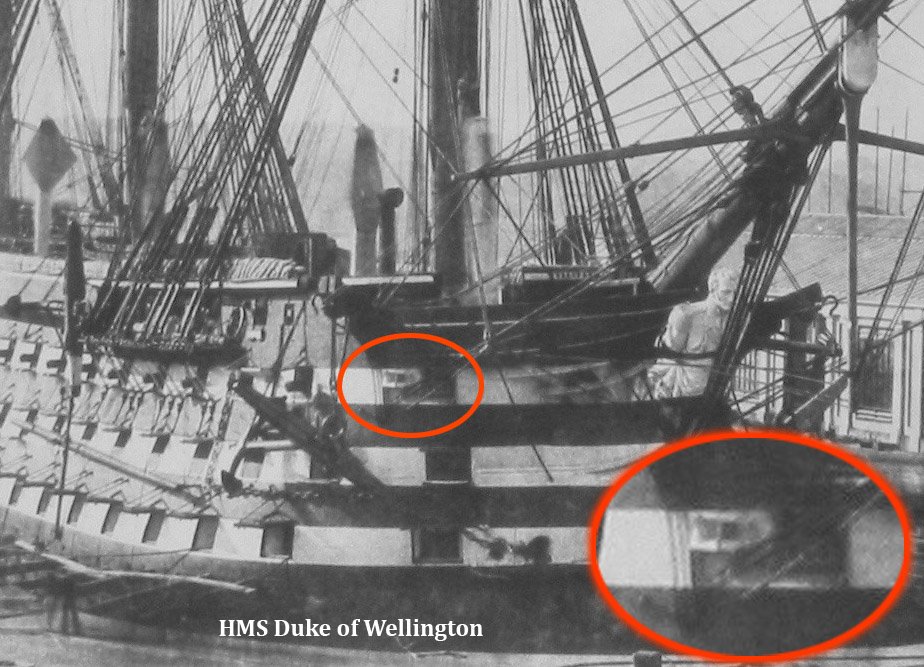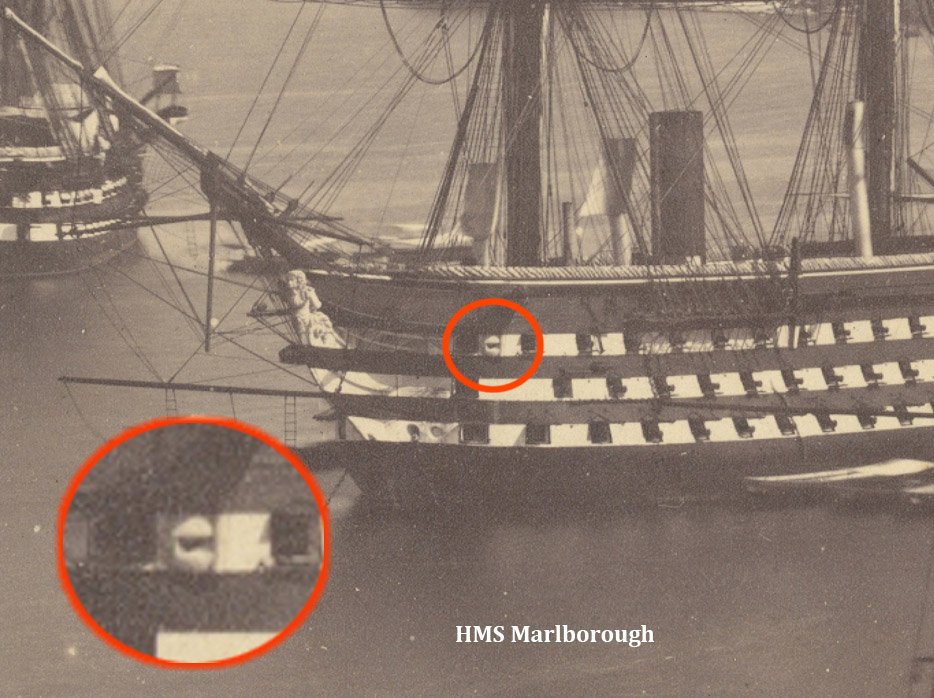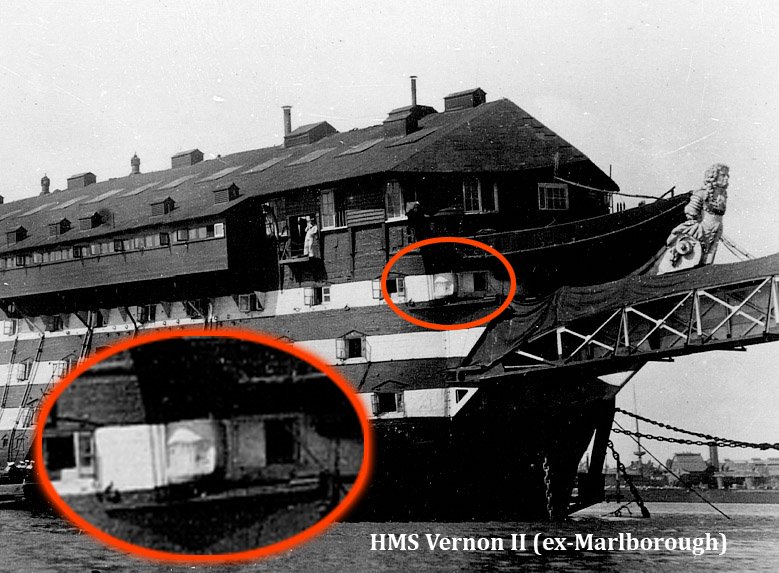
Martocticvs
Members-
Posts
21 -
Joined
-
Last visited
Content Type
Profiles
Forums
Gallery
Events
Everything posted by Martocticvs
-
What sails did a ship like Vasa have set in severe weather?
Martocticvs replied to ubjs's topic in Nautical/Naval History
Also depends on period, and possibly also nation. Earlier British/English ships would reduce to courses in strong winds. Later that practice changed to close reefed topsails, and no courses. [Edit] looks like that's covered in the image above! -
Also interesting - the wooden steam battleships, including those converted from ships of the line, did not require any ballast at all. The engine and boilers were quite sufficient to act as ballast.
-
Can you identify this feature? 19th century 1st Rates
Martocticvs replied to Martocticvs's topic in Nautical/Naval History
All the photos I've seen show her at anchor, not moored to a buoy. But it does look very much like an early mooring fairlead. Might have doubled up for taking in the end of the anchor chain whilst at sea, if they wanted to disconnect it from the bower anchors. Thanks for your input everyone! I think my model of this beast is still some way off yet, but looking forward to it -
Can you identify this feature? 19th century 1st Rates
Martocticvs replied to Martocticvs's topic in Nautical/Naval History
I wonder if that is a slight misunderstanding/confusion... besides the regular 32 pounders, she was carrying several 8-inch shell guns at launch, and going by the refit plans, these stayed with her until the end of her commissioned life. The 68 pounders had a calibre of a little over 8 inches, so these two guns could perhaps be muddled without delving into it further... -
Can you identify this feature? 19th century 1st Rates
Martocticvs replied to Martocticvs's topic in Nautical/Naval History
So this is still in the back of my mind as a future project, and whilst doing some browsing through the IWM catalogue earlier, I stumbled across a few photos of Marlborough from sometime between 1903 and when she was sold off for scrap. There's not any information on this photo to date it*, however it is *very* clear, and we get a fantastic shot of this feature! And I'm still none the wiser 🤪 https://www.iwm.org.uk/collections/item/object/205274093 [Edit] This lithograph https://www.iwm.org.uk/collections/item/object/205262052 appears to show the anchor chain being led up to that feature. Perhaps a hook of some kind was passed out through what definitely looks like a small opening and used to haul the anchor chain up out of the water when underway... [Second edit] *Since there's a lack of an enlarged opening in the bow where the bridge was attached, and there being another photo dated 1903 which shows her housed over, with a bridge running into the bow of her near-sister HMS Duke of Wellington, this photo must be earlier than that. In 1904 she was added to HMS Vernon. -
I've just finished looking through this entire thread - stunning workmanship! She's coming together extemely well
-
Can you identify this feature? 19th century 1st Rates
Martocticvs replied to Martocticvs's topic in Nautical/Naval History
Thanks! That's a nice cross-section. That's clearly a 68pdr or 8in gun in the pivot position on the forecastle, which is in line with the Winfield armament figures. I suspect his figures are correct for the ship between commissioning and 1861. I have been doing some reading today, and have concluded that Marlborough carried an Armstrong 7in (110pdr) RBL on her forecastle from September 1861 onwards, despite the '100 pdr shot' callouts on the plans. This is the very same gun as found on Warrior. I'm confident that it was this gun, as it was originally intended to fire a 100 lb shot, but this was increased before it was put into service (and being a non-spherical shot, this was presumably a relatively simple change). And there are no alternative guns of this calibre. The plans must have been drawn before this change was made/known about. These guns didn't see service for long, as they had low muzzle velocity and poor penetrative performance compared with smooth bore guns of the time; also the breech loading mechanism was prone to problems, and the vent block was another source of issues. The Admiralty quickly concluded that they were unsuitable for use as broadside guns, but acceptable as bow chasers, and they replaced 68pdrs and 8in guns in this position on several ships from 1861 onwards. The 40pdr had been around a little longer, and seems to have been better regarded. Clearly Marlborough put into Portsmouth sometime in 1861 for a refit, during which time her armament was upgraded. A quantity of these 40pdrs must have been brought on board to replace some of the 32pdrs. She must have retained some or all of her 8in guns at this time. It was a period of considerable flux in this regard; I can't rely on published sources for this as the authors are unlikely to convey this degree of alteration for a single ship, and no one has written a book solely on these ships! There still is no decent reference material on the guns of this period either (DK Brown bemoans this in his book Before the Ironclad, which was written 30 years ago!). From a modeller's point of view, the guns themselves aren't too big a problem - but the carriages... -
Can you identify this feature? 19th century 1st Rates
Martocticvs replied to Martocticvs's topic in Nautical/Naval History
OK, now that I'm in possession of the plans I can compare some of these theories with what's drawn. The plans I have are as-fitted plans from 1861, drawn up at Portsmouth Dockyard. Firstly, it can be nothing to do with the Sickbay, since that is located on the Middle deck. There is nothing marked on the Upper (Main) deck plan in this area. The plans are quite detailed with numerous annotations to tell us what various features were, and given that we don't see this feature on other ships, it is surprising that it is missing. So presumably it is a purely external fitting; it does share some similarities with the Port/Starboard lights on HMS Warrior, so perhaps that is the correct theory? Armaments-wise, it gets really interesting (and confusing!) On the forecastle there are racers, pretty much identical to the ones on Warrior - that ship has a 110 pdr mounted there. Marlborough's plans however have a labelled area just aft of the racers for Armstrong 100 pdr Shot. I am aware that they briefly tested a 100 pdr RML, but considered it ineffective. Suggestion here though is that she had one on her forecastle in 1861. Several shot garlands are shown fore and aft of the funnel, but their sizes are not specified (I presume 32 pdr). On the Main (upper) deck, there are several lockers for 40 pdr Armstrong shot, so some/all of the guns on that deck were clearly those. No other shot types are indicated for that deck. On the Middle deck there is quite a mixture. More 40 pdr Armstrong shot locations are marked, as well as garlands filled with 8in shot (sic), and an even larger quantity of 6in shot. I again presume this to be 32 pdr shot, since that has a diameter of a little over 6in, and I'm not aware of any other 6in ordnance from the period... No shot storage is indicated at all for the lower deck. There's plenty more Armstrong 40 pdr storage on the Orlop. In the hold there are a pair of shot lockers (no size given), and a pair of shell rooms. All this gives the strong impression that the 40pdrs formed the main part of her armament at this point in time. Each plan sheet makes clear the ship carries 131 guns at the time, so neither of the dispositions quoted in the Wiki article can be correct for this point in her career. Further research needed, but this mixture makes it rather more interesting IMO! -
Can you identify this feature? 19th century 1st Rates
Martocticvs replied to Martocticvs's topic in Nautical/Naval History
Interesting - I'm working on the information Rif Winfield gives in his book covering 1817-1863. I've never seen reference to an all 68 pdr load-out before! I'm going to have to examine the progress book to set this all in order I think. Duke of Wellington, Marlborough and the other three of this loose 'class' probably bear only an academic relationship with Queen. The design was quite substantially modified between Symonds' departure and their launch under Walker. DoW was lengthened by 25 feet midships 23 feet amidships and 8 feet in the run; Marlborough had the same expansions, plus an additional 5 feet at the bow (which accounts for the extra two gunports there - gundeck and upper deck). The scope of Lambert's book ends before this ship was finished. I wonder if his information refers to an earlier version of the draft? The progress book should reveal all, anyway. -
Can you identify this feature? 19th century 1st Rates
Martocticvs replied to Martocticvs's topic in Nautical/Naval History
Could be... racers are marked on the plans for one of the decks (I think that was the forecastle, for the 'pivot'-mounted 68 pdr - can't quite remember for certain though so will have to wait until my copies arrive). The Wiki article is a little confused I think. These ships were originally designed to be 121 gun pure sail ships. They were lengthened on the stocks to allow the steam engines to be fitted, and so they ended up as 131 gun ships. As far as I can tell, that's how they were when commissioned. Then at some point after she started harbour service (only 9 years later), she was reduced to 98 guns (1870, according to the article) - and I've no idea what they were. It's not clear where the 121-gun armament disposition figures came from in that article so I would treat with a little scepticism for now. Would need to have a look at the Progress Book to find out for sure. -
Can you identify this feature? 19th century 1st Rates
Martocticvs replied to Martocticvs's topic in Nautical/Naval History
To muddy things even further, here's a photo of Marlborough on a different day in Grand Harbour, and there's no sign of it... And this one's amazing - Marlborough in 1855, a few hours/days after being launched (well, the launching being completed, as it took a while!!), and no sign of it here either... -
Can you identify this feature? 19th century 1st Rates
Martocticvs replied to Martocticvs's topic in Nautical/Naval History
Indeed, I noticed that as well - although I would go with removed rather than added, as I think that photo is from a little later in her career (look closely and you can see that additional openings have been cut at orlop level, so she is on permanent harbour service there). -
Can you identify this feature? 19th century 1st Rates
Martocticvs replied to Martocticvs's topic in Nautical/Naval History
There aren't really any clear photos of Marlborough's stern, but there's a fantastic one of Duke of Wellington. I see nothing similar there. I have to assume that it was an experimental fitting of some kind (and the more I loo at it, the more it looks like a projecting feature from the hull, rather than simply an open hatch). Everyone's theories/guesses seem plausible... I'll just have to interpret it as best I can! and keep looking for more photos. Surprising how many there are from that time (good ones, too!) -
Can you identify this feature? 19th century 1st Rates
Martocticvs replied to Martocticvs's topic in Nautical/Naval History
Thanks for the input everyone! The mooring fairlead sounds compelling. I'm waiting for the plans to arrive right now, so it will be interesting to see if there's anything marked on them. I've had a look for photos of these ships' contempories, and I don't see this feature on any of them (not many photos though, Victoria having the clearest photo). Interestingly, a photo of Duke of Wellington during her time as flagship at Porstmouth shows no hint of this feature, and another photo of Marlborough in Valetta also does not show it (similar angle to the photo above, though poorer quality). Presumably either its a case of the port being closed (and the lid painted the creamy white of the hull), or a canvas cover pulled over it as in the photo of her as Vernon. -
I was in both the National Maritime Museum and Science Museum just last week. I recall seeing one such model in each museum, but there were disappointingly few ships models on display in the Science Museum (I compare with a visit there some 25 years ago when there was a good selection, although I was not so interested in them at the time, sadly!) There is another PoW bone model on display inside Chatsworth House in Derbyshire as well, which I believe is on loan from one of the two museums.
-
I'm seriously considering a project to build HMS Marlborough of 1855 (I find these unloved final ships of the line rather fascinating). The lines plans for both her and her very-near sister Duke of Wellington are in far too poor a condition to copy at the moment, but there's enough in the other sheets to reconstruct with good confidence (as-built lines up to gundeck level are present for Marlborough). The presence of a few good in-service photos also helps with these ships! However, I have just recently spotted a feature on these two ships that I've never seen before. It looks a little like a bracket, possibly with a small opening, just abaft the first port on the upper deck. It appears a little more 'naked' on Duke of Wellington; on Marlborough it looks like more effort has been made to blend it into the surrounding hull. The feature was still present, although seemingly covered with canvas, when she was Vernon II. Does anyone know what these features are, and for? And are there any clearer examples of them?
About us
Modelshipworld - Advancing Ship Modeling through Research
SSL Secured
Your security is important for us so this Website is SSL-Secured
NRG Mailing Address
Nautical Research Guild
237 South Lincoln Street
Westmont IL, 60559-1917
Model Ship World ® and the MSW logo are Registered Trademarks, and belong to the Nautical Research Guild (United States Patent and Trademark Office: No. 6,929,264 & No. 6,929,274, registered Dec. 20, 2022)
Helpful Links
About the NRG
If you enjoy building ship models that are historically accurate as well as beautiful, then The Nautical Research Guild (NRG) is just right for you.
The Guild is a non-profit educational organization whose mission is to “Advance Ship Modeling Through Research”. We provide support to our members in their efforts to raise the quality of their model ships.
The Nautical Research Guild has published our world-renowned quarterly magazine, The Nautical Research Journal, since 1955. The pages of the Journal are full of articles by accomplished ship modelers who show you how they create those exquisite details on their models, and by maritime historians who show you the correct details to build. The Journal is available in both print and digital editions. Go to the NRG web site (www.thenrg.org) to download a complimentary digital copy of the Journal. The NRG also publishes plan sets, books and compilations of back issues of the Journal and the former Ships in Scale and Model Ship Builder magazines.


